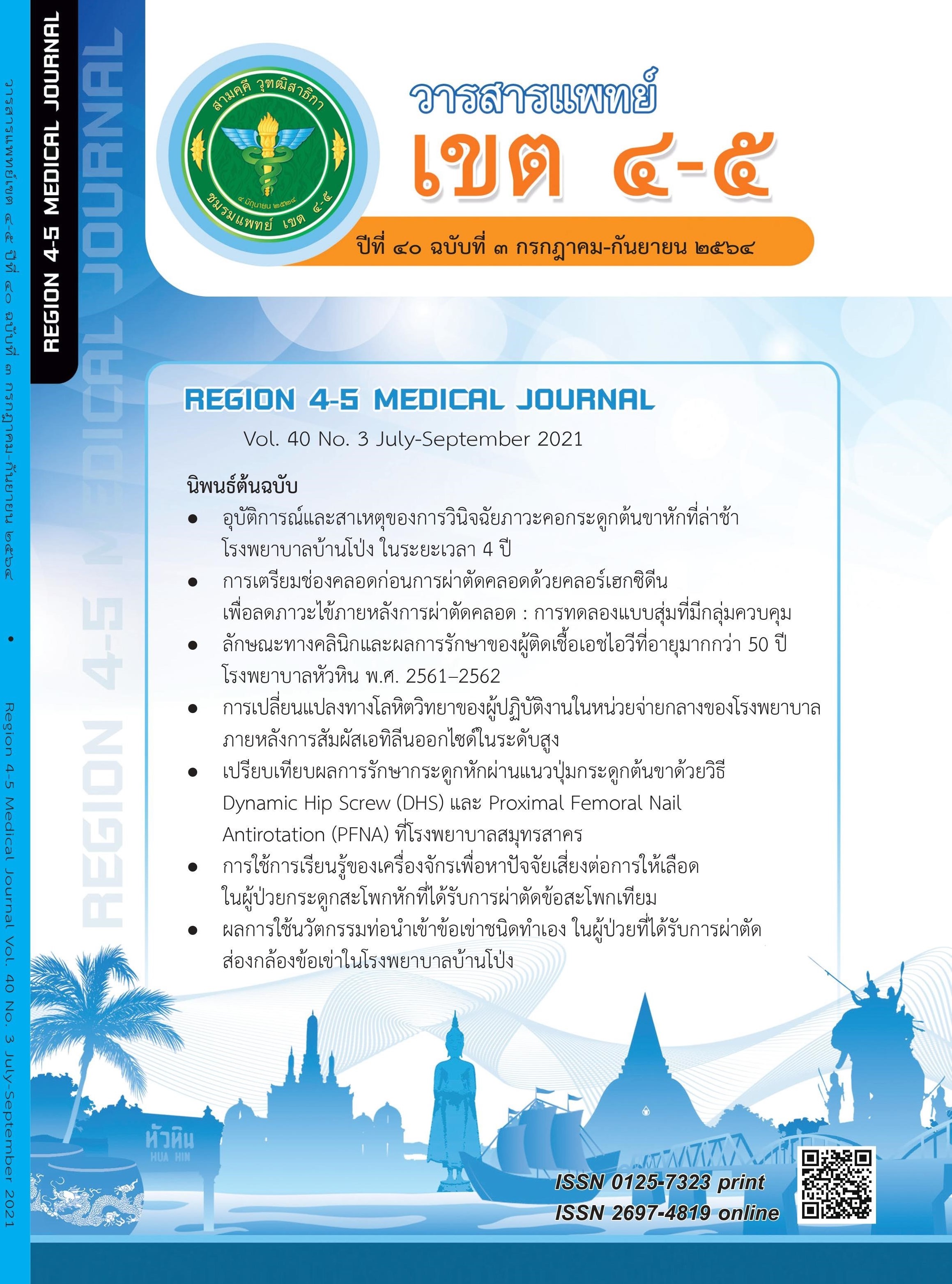อุบัติการณ์และปัจจัยที่เกี่ยวข้องกับอัตราตายปีแรกของผู้สูงอายุกระดูกสะโพกหัก ที่ผ่าตัดในโรงพยาบาลเจ้าพระยายมราช
คำสำคัญ:
กระดูกสะโพกหักชนิดไม่รุนแรง, อัตราตายในปีแรกบทคัดย่อ
วัตถุประสงค์:ศึกษาอุบัติการณ์และปัจจัยต่างๆที่เกี่ยวข้องกับอัตราตายในปีแรกของผู้สูงอายุกระดูกสะโพกหักที่ได้รับการผ่าตัดในโรงพยาบาลเจ้าพระยายมราช
วิธีการศึกษา:การศึกษาย้อนหลังวิเคราะห์จากเหตุไปหาผล (retrospective cohort analytic study) ในผู้ป่วยอายุมากกว่า 60 ปีและมีกระดูกสะโพกหักจากภยันตรายชนิดไม่รุนแรงจำนวน 293คนรวบรวมข้อมูลจากเวชระเบียนของโรงพยาบาลตั้งแต่ตุลาคม2560ถึงกุมภาพันธ์2563เก็บข้อมูลการรักษาในโรงพยาบาลและติดตามข้อมูลต่อจนครบ1 ปีหลังออกจากโรงพยาบาล ในกรณีผู้ป่วยเสียชีวิตยืนยันโดยข้อมูลจากเวชระเบียนหรือระบบทะเบียนราษฎร์วิเคราะห์ข้อมูลโดยใช้โปรแกรมสำเร็จรูปทางสถิติ SPSS version 26สถิติที่ใช้ได้แก่ จำนวน ร้อยละค่าเฉลี่ยและค่าเบี่ยงเบนมาตรฐาน เปรียบเทียบความแตกต่างข้อมูลด้วย chi-square test และ independent t-test หาปัจจัยที่มีผลต่อการตายภายในปีแรกด้วย univariate และ multivariate logistic regression
ผลการศึกษา: ผู้ป่วยทั้งหมด 293 ราย เพศหญิงร้อยละ 81.6 เพศชายร้อยละ18.4 อายุเฉลี่ย 76.9 ปี อัตราการตายในปีแรกร้อยละ 5.1 ปัจจัยที่มีผลต่อการตายในปีแรกได้แก่ เพศชายการพบภาวะแทรกซ้อนหลังผ่าตัดมากกว่า1โรคการพบแผลกดทับหลังผ่าตัดไม่สามารถเดินได้ก่อนกลับบ้านและนอนโรงพยาบาลมากกว่า 7 วัน
สรุป:ปัจจัยที่เพิ่มความเสี่ยงการตายในปีแรกของผู้ป่วยสูงอายุกระดูกสะโพกหักคือเพศชาย พบแผลกดทับและภาวะแทรกซ้อนอื่นๆหลังผ่าตัด นอนโรงพยาบาลนานกว่า1สัปดาห์ ไม่สามารถเดินได้ก่อนกลับบ้าน ซึ่งส่วนใหญ่เป็นปัจจัยที่สามารถควบคุมและป้องกันได้
เอกสารอ้างอิง
2. Wongtriratanachai P, Luevitoonvechkij S, Songpatanasilp T, et al. Increasing incidence of hip fracture in Chiang Mai, Thailand. J Clin Denitom. 2013; 16(3):347-52. doi: 10.1016/j.jocd.2012.07.002.
3. Phadunkiat S, Chariyalersak S, RaJatanavin R, et al. Incidence of hip fracture in Chiangmai. J Med Assoc Thai. 2002; 85(5):567-71.
4. สถาบันวิจัยระบบสาธารณสุข.การดูแลคุณภาพชีวิตผู้สูงอายุที่กระดูกข้อสะโพกหัก.การประชุมชี้แจงแนวปฏิบัติการดูแลผู้สูงอายุที่กระดูกข้อสะโพกหักแก่โรงพยาบาลนำร่อง;6 สิงหาคม 2563;ห้องประชุมจูปิเตอร์ 8-10 อิมแพ็ก เมืองทองธานี. นนทบุรี. 2563.
5. International Osteoporosis Foundation. Facts and Statistics [internet]. 2019 [cited2020 Aug 20]; Available from: https://www.iofbonehealth.org/facts-statistics
6. Kingkaew P, Maleewong U, Ngarmukos C, et al. Evidence to inform decision markers in Thailand: a cost-effective analysis of screening and treatment strategies for postmenopausal osteoporosis. Value Health. 2012;15(1 Suppl): s20-8. doi: 10.1016/j.jval.2011.11.015.
7. Chariyalertsak S, Suriyawongpisal P, Thakkinstain A. Mortality after hip fractures in Thailand. Int J Orthop. 2001;25(5):294-7. doi: 10.1007/s002640100270.
8. Vaseenon T, Luevitoonvechkij S, Wongtriratanachai P, et al. Long-term Mortality after osteoporotic hip fracture in Chiang Mai, Thailand. J clin Densitom. 2010;13(1): 63-7. doi: 10.1016/j.jocd.2009.10.003.
9. Amphansap T, Nitiwarangkul L. One-year mortality rate after osteoporotic hip fractures and associated risk factors in Police General Hospital. Osteoporos Sarcopenia. 2015;1(1):75-9. Doi: 10.1016/j.afos.2015.07.006
10. Choovongkomol K, Lewsirirat S, Piyapromdee U. Mortality and prognosis factors of elderly patients with pertrochanteric fracture: Re-evaluation in Maharat Nakhon Ratchasima hospital. JRCOST. 2015;3-4:3-9.
11. เกียรติยศ จิตทรงบุญ.ปัจจัยที่มีความสัมพันธ์กับอัตราตายในช่วง1ปีของผู้ป่วยกระดูกสะโพกหักจากโรคกระดูกพรุน โรงพยาบาลเพชรบูรณ์.วารสารโรงพยาบาลมหาสารคาม.2561;15(2):13-22.
12. Chaysri R,Leerapun T,Klunklin K,et al. Factors related to mortality after osteoporotic hip fracture treatment at Chiang Mai university hospital,Thailand,during 2006 and 2007.J Med Assoc Thai. 2015;98(1):59-64.
13. Downey C, Kelly M, Quinlan FJ. Changing trends in the mortality rate at 1-year post hip fracture – a systematic review.World J Orthop. 2019;10(3): 166-75.
14. Guzon-illescas O, Fernandez EP, Villarias NC, et al. Mortality after osteoporotic hip fracture: incidence, trend, and associated factors.J Orthop Surg Res. 2019;14: 203. Doi:10.1186/s13018-1226-6.
15. Heantjens P, Magaziner J, Colon-Emeric CS, et al. Meta-anlysis: Excess mortality after hip fracture among older women and men. Ann Intern Med. 2010;152(2): 380-90. doi: 10.1059/0003-4819-152-6-201003160-00008
16. Morri M, Ambrosi E, Chiari P, et al. One-year mortality after fracture surgery and prognostic factors: a prospective cohort study. Scientific reports. 2019;9: 18718. Doi:10.1038/s41598-019-55196-6.
17. Klestil T, Roder C, Stotter C, et al. Impact of timing of surgery in elderly hip fracture patients: a systematic review and meta-analysis. Scientific reports. 2018; 8: 13933. Doi:10.1038/s41598-018-32098-7.
18. American Academy of orthopedic Surgeons. Management of Hip Fractures in the Elderly:
Evidence-Based Clinical Practice Guideline [internet]. 2014 [cited 2020 Aug 20]; Available from: https://aaos.org/globalassets/quality-and-practice-resources/hip-fractures-in-the-elderly/management_of_hip_fractures_in_the_elderly-7-24-19.pdf
19. Roche JJ W, Wenn R T, Sahota O, Moran C G. Effect of comorbidities and postoperative complications on mortality after hip fracture in elderly people: prospective observational cohort study. BMJ. 2005; 331(7529): 1374. doi: 10.1136/bmj.38643.663843.55.
ดาวน์โหลด
เผยแพร่แล้ว
รูปแบบการอ้างอิง
ฉบับ
ประเภทบทความ
สัญญาอนุญาต
ลิขสิทธิ์บทความเป็นของผู้เขียนบทความ แต่หากผลงานของท่านได้รับการพิจารณาตีพิมพ์ลงวารสารแพทย์เขต 4-5 จะคงไว้ซึ่งสิทธิ์ในการตีพิมพ์ครั้งแรกด้วยเหตุที่บทความจะปรากฎในวารสารที่เข้าถึงได้ จึงอนุญาตให้นำบทความในวารสารไปใช้ประโยชน์ได้ในเชิงวิชาการโดยจำเป็นต้องมีการอ้างอิงถึงชื่อวารสารอย่างถูกต้อง แต่ไม่อนุญาตให้นำไปใช้ในเชิงพาณิชย์




